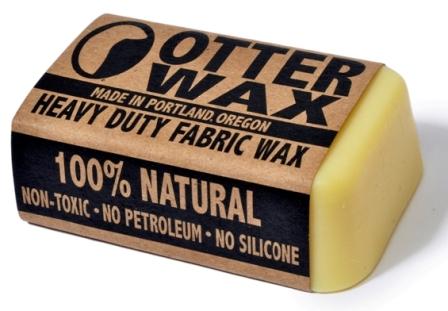A Bedouin tent or beit shar is made of woven fabric from long strands of goat hair. When (rather rare there) rain falls, wool fibers absorb water and expand. That makes stretched canvas water-resistant. Cotton fibers have this property also.
A tightly woven, stretched canvas with sufficient gradient (slope) so may stop rain. It will leak where it sags and water remains in puddles and where it has contact with bearing supports (tent pole, ribs... or your head).
'1100 Tips for the housewife ' (Dating from around 1950?) has a tip # 246:
Tents and tarpaulins are made waterproof, if one puts them in a lye for several days, which is obtained when one cooks about 1 pound oak bark in about 8 liters of water. After the soak rinse well. (A pound is slightly less than half a kilo.)
Perhaps one can also do something with milky sap of dandelions, which contains some latex?
 The Celts made waterproof coats. The wool was tightly woven, then cooked and combed causing water droplets adhere to the outer delinted hair fluff without making the base become wet .(I assume that felt was created by the cooking.)
The Celts made waterproof coats. The wool was tightly woven, then cooked and combed causing water droplets adhere to the outer delinted hair fluff without making the base become wet .(I assume that felt was created by the cooking.)
Witch hat or pointed hat: it seems to me that this is the ideal basic shape to make a virtually waterproof hat made of felt that is combed down in one direction.
Leather coats were wax or oil rubbed to make them waterproof. As we still do that with shoes.
Wool fat can be (mixed or not with beeswax and (soybean) oil) used in order to keep textile waterproof. (See < Ointment, cream, vaseline >
Textiles for outside (sails, fishing nets) are just like leather soaked with tannic acid (tannin). It will last longer than 4x
Cotton and others clothing was traditionally made waterproof with melted wax, (wool, etc.) fat, or by impregnation with (line) oil. Textile and product heating ensures better adhesion and penetration. Of this oil skin tough outerwear was made, which was usually yellow to brown colored by the used substances. The southwest is the by (shrimp) fishermen and firemen carried matching hat with wide edges and continuous far back to run off the water without it runs between the neck and the collar of the jacket. In warm weather, oil skin was annoyingly sticky and clogging stiff in cold weather.
In the Royal Museum of Art and History in Brussels you can see a Brazilian Tupinamba (= Indian tribe) cloak that was once (mistakenly) attributed to Moctezuma. In a knotted net, red and yellow feathers were attached roof-tile pattern from bottom to top. The Museum of Ethnology in Leiden has a similar Hawaiian 'ahu'ula.
In Japan oiled paper was used for umbrellas and a kind of oil skin.
Waterproof clothing don’t remain watertight for years. You have to deal with regularly. That includes contemporary (even expensive) stuff.
